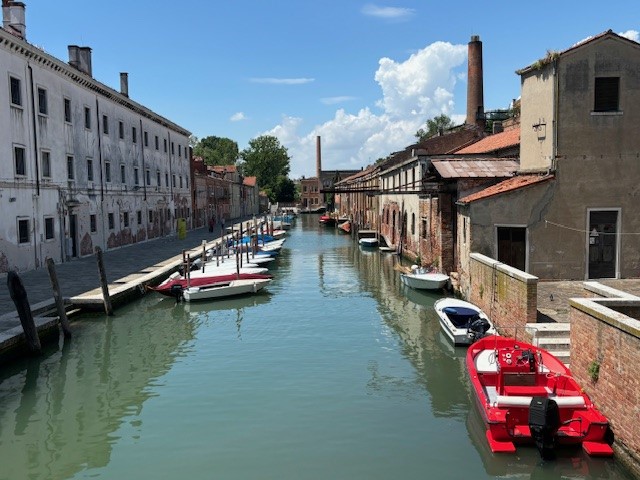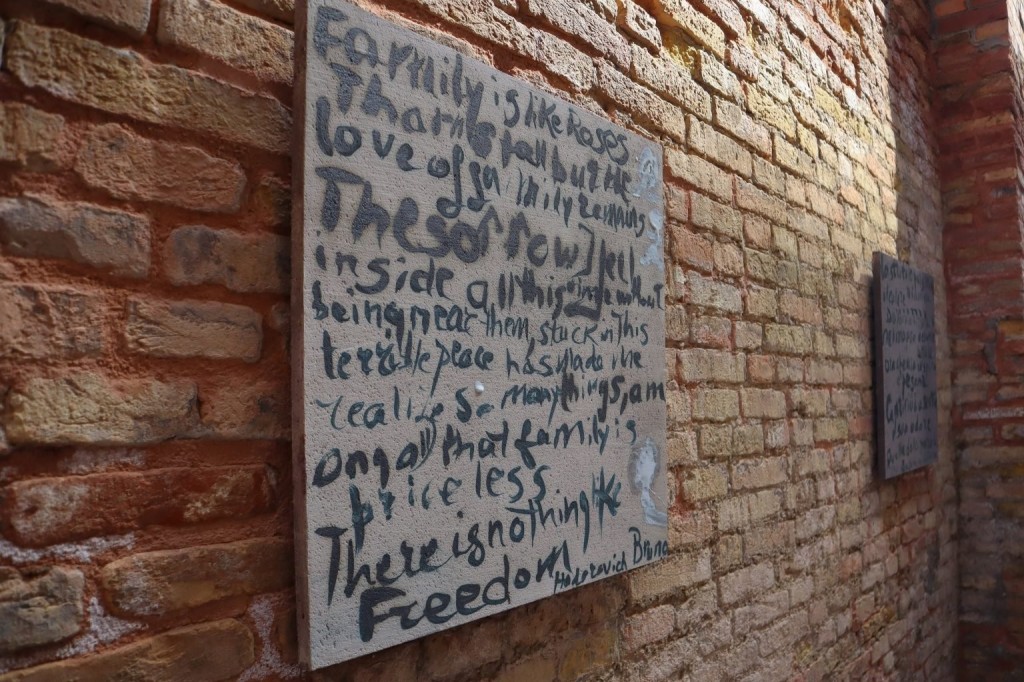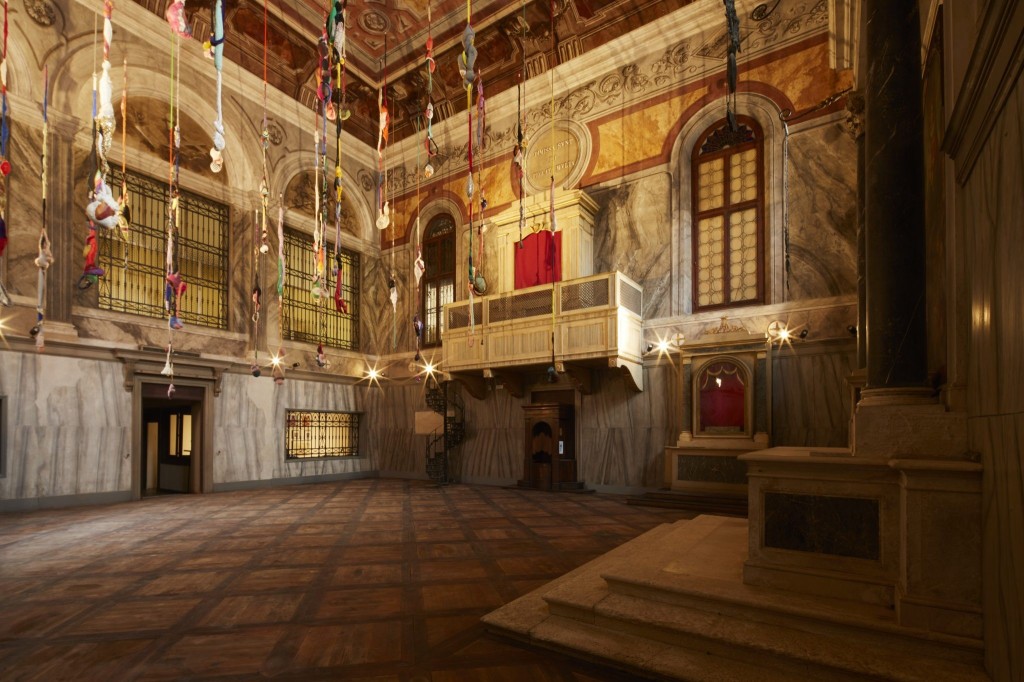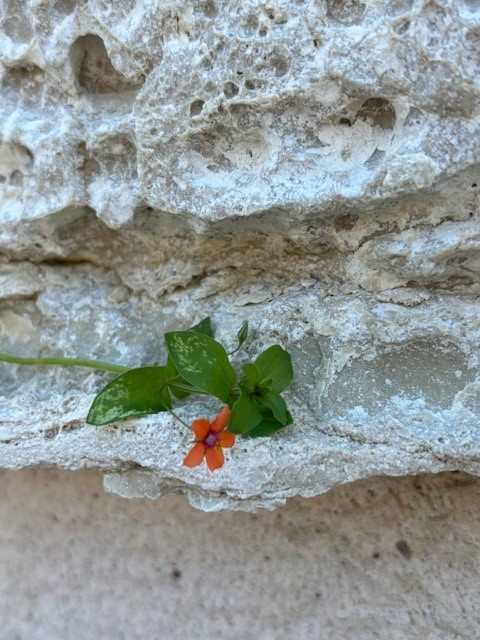The Women’s Prison in Venice is an unlikely location as part of this year’s Biennale in Venice. However The Vatican has selected this ‘Casa di Detenzione Femminile’ as the venue for an art exhibition entitled ‘con i miei occhi’ meaning ‘with my eyes’….. The prisoners are the guides at the venue. Here are a few of my thoughts and impressions…….
Paint is flaking off the door and with every hour of sunlight a little more rises from its mooring and floats down to the ground, like a feather, swirling gently in the imperceptible breeze. Next to the door is a wooden table loaded with vegetables grown in the prison garden and sold to local people every Thursday morning.
A loud clanking noise, the sound of a metal bolt sliding in a well-oiled cradle, echoes from the inside. The door opens forcefully. A prison guard motions me forwards demands proof of identity, seizes my passport and disappears into an office. She returns and directs me to a locker where I’m told to put all my belongings; phone, bag, water, notepad, everything. Access to the ‘Casa di Detenzione Femminile’ is permissible only with empty pockets and no stuff. No pictures, no photos, nothing. I’m part of a small group, the exercise is repeated for every visitor. This is the first time the Women’s Prison has hosted a Biennale event.
Two of the prisoners act as our guides, they introduce themselves as Patrizia and Marcella. They are wearing matching cotton smocks over their own clothes. They read from a prepared script explaining the different artists exhibiting here (there are ten) and the work we will see. They remind me of Virgil leading Dante through the ‘Inferno’. We proceed into a high-walled brick passageway. At the end is a watch tower.
The artist’s collective Claire Fontaine, based in Palermo, have mounted an eye with a diagonal line through it at the end of the passageway on the brick wall. It is a human eye with a line through it, like the signs you see at a swimming pool that indicate no photography, no jumping, no diving. Here at the prison the message is ‘no seeing’. The juxtaposition of the eye directly below the watch tower is powerful. This is a community out of view, hidden away, excluded from the outside world, deprived of their freedom.
The passageway is the entrance to the prison and the start of the Biennale Exhibit hosted by The Vatican. The walls are lined with square, volcanic stone plaques each inscribed with the words of the inmates taken from letters they’ve written to loved ones. They are disturbing to read, one says, ‘stuck in this terrible place’, ‘family is priceless’ and heart-wrenchingly poignant ‘freedom is everything’. The woman behind these stones is Simone Fattal, a Damascus-born artist. We have very little time to absorb the power of these words before being moved on into the garden. Here there is sunshine and light, fruit trees, tomatoes and vegetables, all tended by the prisoners. Marcella, who is Colombian and for whom Italian is not her first language, points out a window that looks out onto the garden, the only one without bars she explains.
Inside the prison we enter a mess room decorated with posters by Corita Kent, the former nun and Beat Generation Poet/Artist of the 1970s. The message here is dissent and anti-war rhetoric. But this ‘installation’ isn’t about the artist it’s about the prison and those detained within its walls. As we emerge into the central courtyard where the inmates can chat and stroll and smoke there’s a huge neon sign (Claire Fontaine again) saying, ‘Siamo con voi nella notte’ which means ‘We are with you in the night’ and whilst this is a very pleasant and caring sentiment it is patently untrue.
The prison guards supervising our visit are unobtrusive and yet very present. We are moved on from the courtyard into a side room. Here there’s a film for us to watch. It is about a detainee waking up on her release day, collecting her belongings, saying her goodbyes to her friends and making her way step by step to the outside world. Zoe Saldana is the actor, the prison inmates are the cast. Filmed in black and white it acknowledges the bleakness of life within the prison and the absence of freedom. I immediately think back to the lava stone on the wall at the entrance where a prisoner had written ‘freedom is everything’. She is right – it is.
Next there’s a room filled with photos of children. Marcella points out her own son, who was 8 years old when the photo was taken, he is now 12 she informs us. Then she told us how she likes to write. A journalist in our group turned to Marcella and said, you need to write this down, you need to record your story, you have a unique story here and it needs to be shared. We were moved on again, this time into the prison chapel. Here Sonia Gomes, an artist from Brazil has created a series of hanging woven fabrics, 34 in total that cascade down from the ceiling in colourful, contorted rivers of material. The chapel is a reminder of the prison’s past when it was a convent. One of the prison guards taps her watch to indicate that our time is up. We start to say our goodbyes.
Then Marcella walked up to the journalist and gave her a tiny flower, from the prison garden, a delicate bloom of burnt orange with bright, green leaves. A small gift from a prisoner to a visitor, a way of saying thank you. She vowed that she would write her story and one day get it ‘out into the world’.
As we emerged through the heavy metal doors into the brilliant sunlight of the Giudecca the contrast between the closed, barred world of the prison and the open, unfettered atmosphere of Venice was intense. I noticed the wooden table next to the door, empty and abandoned, all the produce from the prison garden had been sold. Next week it will be replenished and the locals will come and buy the bounty of the prison garden once more. But the prisoners don’t get to see this simple weekly transaction because they are kept firmly behind locked doors.


Peaceful canal where the Women’s Prison is located (left). One of the lava stone plaques, conceived by artist Simone Fattal that the prisoners wrote on. Photo: Naomi Rae (right)


Left – The chapel at the Women’s Prison – art installation by Sonia Gomes – Photo: Marco Cremascoli. Right – the flower given by our guide to my friend the journalist Cat Bauer. Photo: Janet Simmonds
Notes:
- With special thanks to Cat Bauer, whose kindness shaped this visit for all of us.
- This article is really an exercise in appreciation – our freedom is everything without it we have nothing. In the words of Abraham Lincoln, “For to be free is not merely to cast off one’s chains, but to live in a way that respects and enhances the freedom of others.”
- The author is a writer, tour guide and lecturer specialising in Italy.
- For more information visit: www.greyhoundtrainers.com
- For tailor-made, high quality journeys in Italy it’s our sister company: www.grand-tourist.com
July 2024

What a brilliant article, Janet; An insight inti a place and a way of life which thankfully (I hope!) will be unknown to all your readers
Having been a regular visitor to Wakefield Prison over the years, I have a slight (but only slight!) familiarity with a “life behind bars”, and the consequent disproportionate importance of the words “Freedom is everything” (a welcome and much more encouraging than the other not dissimilar phrase in an even more unfortunate place “Arbeit macht frei”).
You really brought out the reality behind this alien world and I must congratulate you on providing yet another fascinating glimpse into a part of Venice of which even those of us lucky enough to be familiar with the City of your dreams would never have been aware.
Thank you again,
John
LikeLiked by 1 person